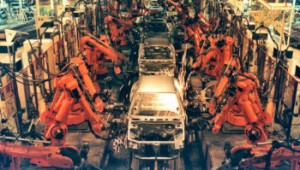Manufacturing and metros are recipe for success, says guru on cities

Bruce Katz has pushed a consistent message for Michigan: M&M&E.
That's short for manufacturing, metros and exports. A vice president at the Brookings Institution, Katz has worked in recent years with Business Leaders for Michigan in developing ideas for improving Michigan’s economy.
Bridge Magazine spoke with Katz by phone recently to get his sense of how Michigan’s recovery is doing – and what policy decisions are still lacking to bolster the state’s economy.
Bridge: In your testimony before the House Commerce Committee in May, you noted that Detroit and Grand Rapids ranked highly for export intensity. What is export intensity and why is it important in economic policy considerations?
A: Export intensity is a measure of the share of total output in the metropolitan area that is exported. Nationally, exports are around 11 percent of total gross domestic product, but in strong manufacturing metros, it’s higher. Detroit is about 14.9 percent and in Grand Rapids, it’s 15.3 percent. So there is just greater export intensity in the manufacturing metros and what we found is that 13-14 metros in Michigan are actually more exporting intense than the U.S. economy as a whole.
You know that matters because you know global demand is raising the U.S. economy, which has been underperforming because we have such a large domestic market. So with the Great Recession, the recovery that we have had to date is still not sufficient. What we have had today has mostly been fueled by global demands, particularly in countries like China, Brazil and elsewhere. … As the century unfolds, we are going to find ourselves doing more business abroad and for cities and metropolitan areas, they are going need to understand what they trade and who they trade with.
Bridge: Is it fair to say, based on these export intensity figures, that Michigan is actually further along than the rest of the country?
A: What it shows is that you are a production powerhouse, both in the large metros and smaller metros. For a long time, we have treated manufacturing differently with the old economy; actually manufacturing is completely fueled by technology innovation. … There is a future for manufacturing in the United States for a lot of different reasons and those places that are manufacturing hubs obviously have a jump on everyone else. The question is whether they understand it and are doing what is necessary to continue to move forward.
Bridge: In 10 to 20 years, how big a share will manufacturing carry in the economy and how many jobs will it provide?
A: Well these are the numbers I think are important to start the conversation: Manufacturing in the United States is 9 percent of jobs; it’s about 11 percent of GDP and employs about 30 percent of all engineers in the country. It accounts for about 68 percent of all private research and development and it generates 90 percent of the patents in the United States.
I just came from a tech-economy conference in Detroit, which is a conference on technology innovation. A large portion of the conference was about manufacturing and, again, I think we had almost a cartoon conversation about manufacturing where we talked about the old economy is manufacturing and the new economy is Facebook. This is a completely absurd conversation.
Manufacturing is still very productive in the United States. We are the third largest exporter in the world behind China and Germany and that is without any policy at the national scale that frankly is even remotely coherent.
The U.S. has spent the last 25 years basically trying to move to what we call a post-industrial economy. What we have done primarily through the federal tax code is subsidize consumption and real estate. We have provided feelings for production and innovation. So we got it all backwards frankly, compared to our competitors.
Manufacturing … will not employ as many people on the factory floor because we will be more automated and driven by technology, but it will have jobs that are along the very robust continuum from research and development to commercialization and innovation, continuous innovation, design, industrial design, industrial marketing, trade and logistics.
Bridge: You had pointed to an innovation district in Barcelona, Spain. How would that apply to Detroit as a case study? How would it change day-to-day life there?
A: Well, I am really thinking about the three-mile quarter that runs from downtown to Midtown. You have a cluster of tech firms that are located in downtown … Quicken Loans, Compuware, other firms that are highly reliant on tech workers and then you have these anchor institutions in Midtown like Henry Ford Medical, the Detroit Institute of Arts, etc. These are very innovative institutions that employ many innovative and talented workers. …
My sense is that Detroit is a very much a town of two cities, while the broader city is very large and facing a huge fiscal crunch, the core of the city actually has potential to build out over the next 15 to 20 years and be a robust source of growth, in terms of jobs and tax revenues for the entire city and entire metropolis. There could be a talent magnet, so to speak.
Barcelona, over the course of decades, has really transformed its economy and has been very intentional about growing an innovation district that relates to its business and competitors, universities, media firms, tech firms. The key is to think about a community that includes not just business for innovative institutions and research institutions, but how things lead to amenities. …
The one thing you learn in city building is to go own your strength, build on your assets and your distinct advantages. You know many older industrial cities do not have what you have in Detroit. It is a very dense geography that inter-mixes these innovative firms and these anchor institutions; these increases can be a platform for residential and other transformations. This is a distinct advantage you have. Why not double down, triple down and find that right kind of public and private sources to totally build this out? …
Another thing about Detroit, you can see Canada – your trading partner is literally right across the river. I don’t think that’s a relationship that has been exploited.
Bridge: What’s your view of the plan to build a second bridge between Detroit and Windsor, Ontario?
A: This is not a really complicated situation. This is one of the biggest trade routes between the United States and Canada, which is our biggest trading partner. The Ambassador Bridge was completed, I think, weeks before the stock market crash, and it can’t meet the growing demand. The only issue here is we have a private owner of the bridge who obviously wants to keep a monopoly, and is doing everything he can to try and block what is a no brainer in terms of investment. …
Infrastructure fuels competitiveness. Infrastructure fuels growth. You’ve got to continue to modernize your infrastructure, you have to continue to adapt to new dynamics. … If the United States had a coherent trade policy coming from our national government, which most countries do, we really wouldn’t be having this conversation. I mean it just brings what a country does, brings its trade links, and the infrastructure that enables those trade links – whether they’re in a port or an airport or a bridge crossing.
Bridge: In 2006, you argued that Michigan needed education for income growth, and noted that more compact development patterns help productivity, while government fragmentation hurts it. From that vantage point, where would you say Michigan stands in 2012 versus 2006?
A: You’ve got a lot of challenges. Again, to some extent, they’re inherited challenges. In a sense, you’ve got too much government – you’ve got the 12th most number of local governments in the country, so you’ve got a governmental structure that was erected in the 19th century for the 21st century – it doesn’t make any sense.
Education: Obviously we’re moving to an economy – we’re already in the economy -- that is highly dependent on talented workers and highly dependent on a K-20 system to educate and train those workers, or, frankly a pre-K-20 system. And so, a part of that is related to finance, and part of it is related to educational achievement, making sure that your resources are going in the right way, and that you reward schools that perform and you intervene when schools are not performing. So, that’s part of the new reform system that is being set up in the state. …
What you do need to do is to collaborate across city and county lines in those things that matter like infrastructure, and at the state level, make those kinds of investments in pre-K-20 that are essential to keep you ahead of the curve in terms of educating and training more residents. I mean, you inherit, on the positive side, one of the best public university systems in the country, if not in the world. University of Michigan, MSU, Wayne State, right? I mean, you’ve got really phenomenal higher ed here.
Bridge: What is the principal policy behind the belief in local control versus government consolidation in regionalized services? You mentioned the fact that we’re dealing with a 19th century governmental structure and yet it’s proven to be difficult to change it since people seem very committed to the concept of local control. Why is that?
A: Well, it’s political control. I’ve been thinking about it in terms of scale, and it’s a 21st century scale. You know, Louisville (Kentucky) consolidated their city and their county essentially about 10 years ago. Because, they already had a unified school district, then they consolidated the city and the county so that they would have one unified vision on economic development, one land use plan, one infrastructure strategy, one investment strategy, as opposed to everyone having their own different local tax rates, different zoning and the rest of it.
I mean, the question really is, are you built for a fiercely competitive global economy? Businesses want to have easy transaction, and know that they’re dealing with a government at the local level that is really where the action is. …
I don’t think we’re going to dismantle these governments anytime soon. People feel very far removed from the federal government, which might as well be another planet for all intents and purposes. But they feel very close to their municipal government, so if we keep all these little boxes, so to speak, we should just think of a way for them to work together as they’ve done in Denver, Chicago and other places. You make the big decisions at the metropolitan scale. That’s part of competitiveness. It’d be nice if the world was a different place, but the world is what it is.
Senior Editor Derek Melot joined Bridge Magazine in 2011 after serving as an assistant editorial page editor, columnist and reporter at the Lansing State Journal, where he covered state and local issues extensively, earning awards from the Associated Press and Michigan Press Association. The Oklahoma native moved to Michigan in 1999.
Business Watch
Covering the intersection of business and policy, and informing Michigan employers and workers on the long road back from coronavirus.
- About Business Watch
- Subscribe
- Share tips and questions with Bridge Business Editor Paula Gardner
Thanks to our Business Watch sponsors.
Support Bridge's nonprofit civic journalism. Donate today.
See what new members are saying about why they donated to Bridge Michigan:
- “In order for this information to be accurate and unbiased it must be underwritten by its readers, not by special interests.” - Larry S.
- “Not many other media sources report on the topics Bridge does.” - Susan B.
- “Your journalism is outstanding and rare these days.” - Mark S.
If you want to ensure the future of nonpartisan, nonprofit Michigan journalism, please become a member today. You, too, will be asked why you donated and maybe we'll feature your quote next time!



